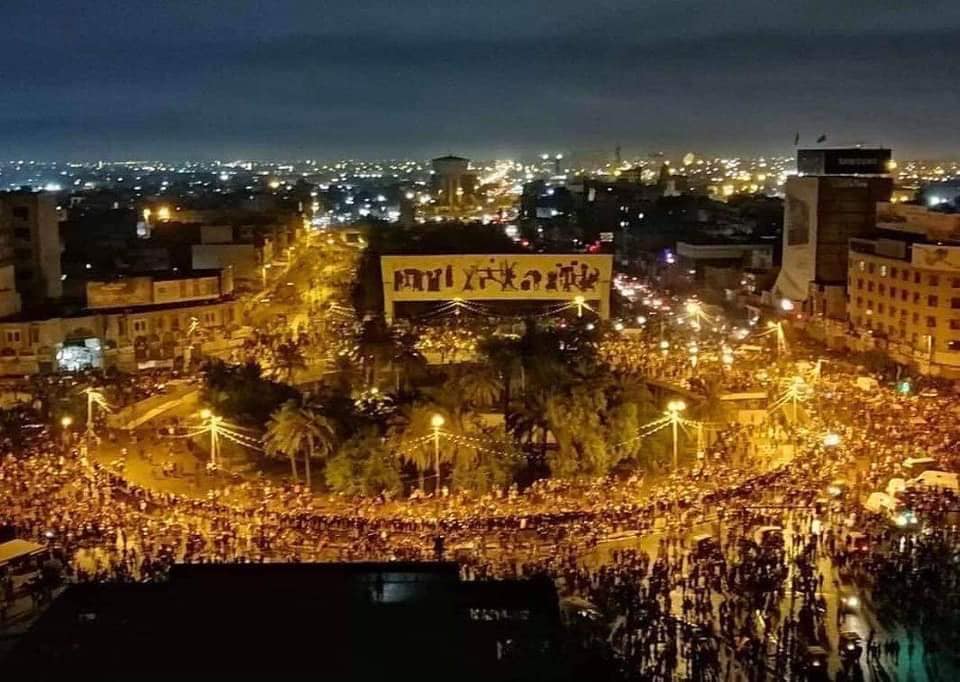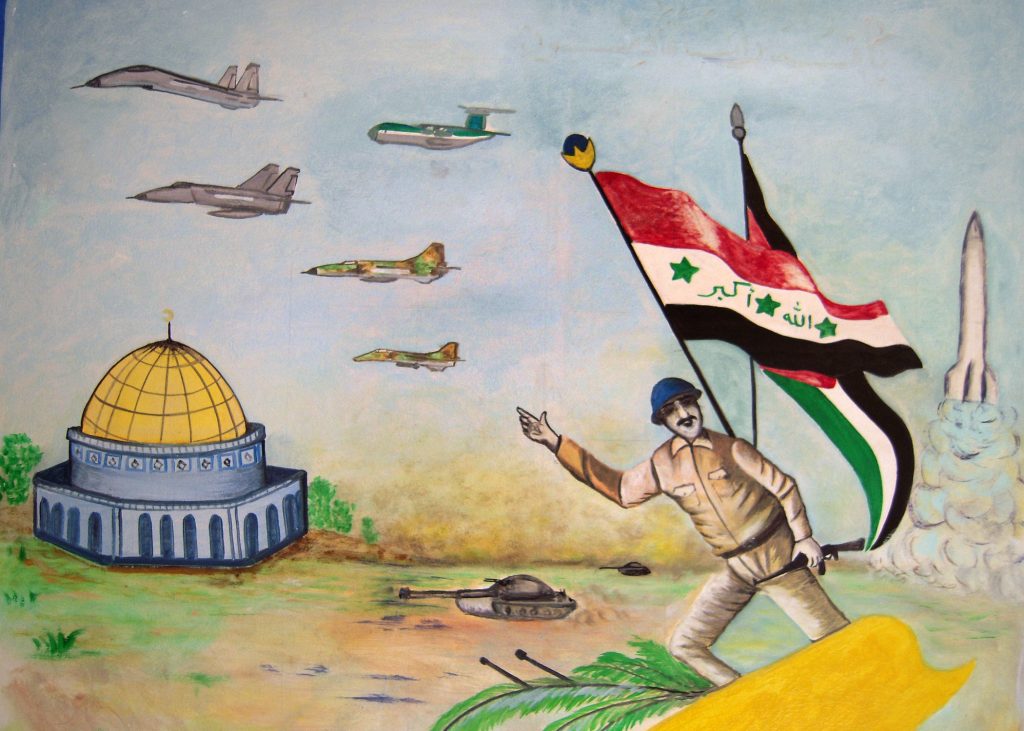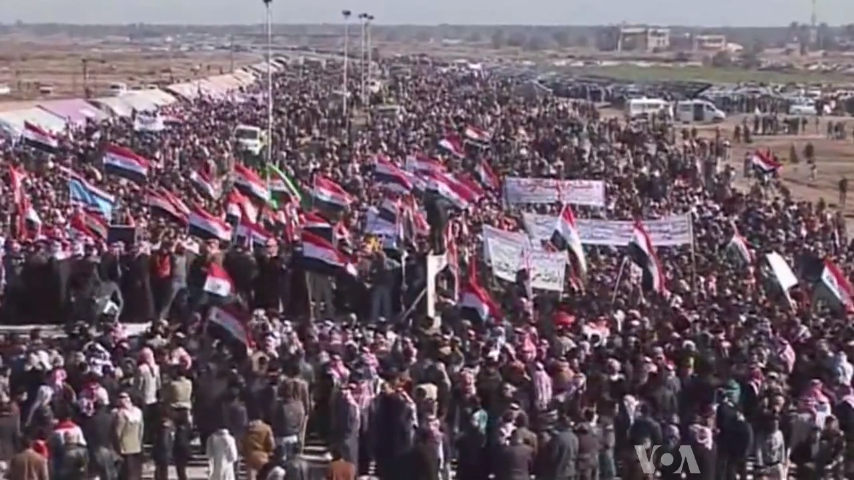
Red smoke covers the holy city of Karbala. A sea of people floods Tahrir Square. Women and men chant together for the removal of the government. The Iraqi flag hovers in the air. Salah Al Suweidi, one of the protestors, says, “We want the government gone. Our demand is not for Abdul Mahdi to resign, it’s not enough. Parliament must go, the parties must go.”
As the calendars marked the beginning of 2018, hope for a better future overflowed the streets in Iraq. The Islamic State had been reportedly defeated and talks of political reform, despite the ongoing corruption, lack of basic necessities and high unemployment rates, were underway. Yet seven months after the defeat of ISIS and the ‘rebirth’ of Iraq, protestors once again flooded the streets. The first post-ISIS elections had proven themselves to be a replica of the previous ones. People wanted change, and yet it appeared that the same political entities had been recycled yet again. With the removal of Lt. Gen. Abdul-Wahab al-Saadi from his post as the commander of the country’s elite counterterrorism forces on September 28, 2019, the protests saw a drastic change in rhetoric and size.
As the protests grew, Iraqi state security forces started using violent measures. Amnesty International has reported that Iraqi forces used live ammunition “on peaceful protestors and resorted to excessive and often lethal force to disperse them in a reckless and utterly unlawful manner”. Since the start of October 2019, more than 300 protestors were killed by the State forces. Meanwhile, Major-General Abdul Karim Khalafah told reporters at a press conference on Wednesday, 30th of October “clear and strict instructions have been handed down that no live ammunition be used”. Government officials have also announced that there will be an official inquiry into the usage of live ammunition, denying the government’s involvement in the shooting of protestors. In fact, Iraqi state officials told Reuters that “Iran-backed militias deployed snipers on Baghdad rooftops”.
Who is Lt. Gen. Abdul-Wahab al-Saadi? Why has his removal caused the escalation in the protests? What were Iran-backed militias doing on Baghdad rooftops? And how can the government not control militia groups deployed within the capital?
When al-Saadi’s removal was announced on September 28, the hashtag #كلنا_عبد_الوهاب_الساعدي (#we_are_all_abdul_wahab_alsaadi) started trending on twitter. Al-Saadi led the Golden Division (Iraq’s elite counterterrorism forces) at the battle of Mosul and Tikrit against the Islamic State. He became popular among the Iraqi people for his nonpartisanship and selflessness during the war against terror. Al-Saadi rejected Irani militia’s involvement in all operations he led against ISIS claiming that if he had accepted help from non-Iraqis, “the history books” would say that the victory was not theirs, the Iraqi’s. According to him, “zero tolerance for sectarianism” is the reason for Golden Division’s success. Overall, Al-Saadi is considered a national hero who liberated the country from terrorism. Hence, when he was removed and demoted from his position, many speculated it to be a decision made by Iran-backed politicians who feared Al-Saadi’s popularity and his open fight against the corruption within the Iraqi Counter Terrorism Forces.
The protests today embody the ideals Iraqis see within Al-Saadi: a country ripped away from corruption and unified around a national identity.
The Iraqi people want a “homeland”. They want to be united around their common identity: being Iraqi. They don’t want to be American, Iranian, nor Baathist. Yet a homeland gathered around a common identity cannot be envisioned under the current political structure, which advocates for sectarian divide. Hence, the will of the people can only be implemented if the current political system is reformed and new political actors, who don’t partake in sectarian politics, are elected. However, this change must happen organically. During this period of transition external intervention into Iraqi politics must be minimal. Otherwise, in the eyes of the people, the new political system implemented might favor another country, rather than Iraq itself, and thus be considered illegitimate.
Before further discussing the new political system Iraq should adopt, we must analyze the historical context behind Iraq’s current political turmoil.
Ba’athist grip on power

Source: Robert Couse-Baker
In 1968, the Ba’athist-led coup overthrew the left-wing military government. The Ba’ath Party advocated for pan-Arabism and anti-imperialism. It called for the unification of the Arab world under a single state. In 1979, Saddam Hussein took control of the Ba’ath Party and became the president of Iraq. As soon as he came to power, Saddam Hussein purged the party of all members who were not completely loyal to him and launched a war on Iran. The Iran-Iraq war lasted for 8 years, from 1980 to 1988. During the war, in 1983, Kurdish political parties in Northern Iraq led a rebellion with the help of the Irani government. The rebellion ended with the Anfal campaign in 1986. The campaign is also referred to as the Anfal genocide, for in the span of two years Iraqi military forces killed approximately 80,000 Kurdish civilians in villages in Northern Iraq. As of the late 1980s, the Ba’ath party had over 1.5 million members (10% of the population). In 1990, Iraq invaded and annexed Kuwait. As a reaction, the United States with other European allies launched Operation Desert Shield and forced Iraq to withdraw from Kuwait.
Saddam Hussein’s perpetual military invasions into neighboring countries illustrate his aggressive and assertive political strategy and his desire to have greater control in the Middle East. Moreover, the Anfal Genocide, alongside the political purge of 1979, shows that he kept political opposition under control through terror.
2003 US Invasion and sectarianism within Iraq
After the 9/11 attacks, G. Bush declared war on the ‘Axis of Evil’, in which Iraq was an enlisted country. During his State of the Union address, Bush declared that “Iraq continues to flaunt its hostility towards America and to support terror”, referencing Al-Qaeda. He also mentioned Iraqi regime’s plot, despite restrictions from the United Nations resolutions, to “develop anthrax and nerve gas and nuclear weapons for over a decade.”

Source: Voice of America News: Selah Hennessy reporting from London, UK
Hence, on March 20, 2003 the United States led a military intervention into Iraq with the British Armed Forces and Saddam Hussein’s regime collapsed in three months. Paul Bremer III (an American diplomat) assumed the title of Interim President of Iraq as a new constitution was written and democratic transition was made. He disbanded the Iraqi Army, ‘sending hundreds of thousands of well-armed men into the streets’. This decision essentially enabled the growth of Sunni Islamist extremism within Iraq. Many officers in the Iraqi army, who were once loyal to the Ba’ath party, were recruited by ISIS in the years which followed the invasion.In 2005, Iraq adopted its new constitution. The same year, for the first time in an Arab-majority country, a Kurd became head of state – Jalal Talabani. Jalal Talabani had fought Saddam Hussein for years before the invasion. His nomination as president caused uprising tensions among the Shiites, Kurds and Sunnis, which eventually led to the 2006 Sunni-Shiite civil war.
Moreover, Shiite militia groups gained considerable power after 2003. With these militia groups, however, Iran also infiltrated into Iraqi politics. On the other hand, Arab sunnis were marginalized from Iraqi politics. Moreover, a year after the invasion, a presidential commission concluded that there were nearly no weapons of mass destruction in Iraq, further delegitimizing the invasion and the new Iraqi state.
Iranian influence
The ongoing protests in Iraq are renouncing external influence in Iraq, most particularly that of Iran. Many politicians who came to power after 2003 were ‘enemies’ of the Ba’ath Party and allies of Iran during the Iran-Iraq war. Hence, their secret relationship with Iran post-2003 comes as no surprise.
Moreover, during the war against the Islamic State, many popular militia groups – not directly under the control of any government – were formed. One of these militia groups is the Popular Mobilization Forces (PMF), an Iranian-backed militia group. Even though on July 1, 2019, the Prime Minister Adel Abdul Mahdi issued a decree directing the PMF to subjugate itself to the Iraqi state, the militia group still symbolizes the hard power Iran holds within Iraq. The presence of the Iranian-backed militia was severely felt early on in the protests as many reported Iranian-backed snipers were shooting protestors.
Finally, on November 17, 2019, the Intercept and the New York Times revealed that documents composed of 700 pages were leaked by an anonymous source. These documents exposed the Iranian spy net within Iraq and how Iran since 2003 has been a significant actor in Iraqi politics. Indeed, since 2003, the Iranian government has been actively eliminating Sunni opposition to Shiite political leaders, in order to prevent the revival of pan-Arab, Sunni ideology at its border.
The Protests Today and the Demands of the People
Since 2003, sectarian tension within Iraq has halted all real change and development. This sectarian tension, as explained above, was fuelled by foreign influence. However, today, more and more Iraqis vote based on economic and social interests. The polls, combined with the protests, show that the struggle among tribes and sects do not concern the general public, but mostly those in power.
Hence, in order for the will of the people to prevail in Iraq a new political system must be established. New parties, not based upon tribal relations, but gathered around economic and social policies must be formed. These new parties must have new faces. Once these new political actors are voted, a new constitution which would solidify Iraqi national identity must be written. This political transition however cannot be imposed upon Iraq. It has to come organically within the country. Nevertheless, once the Iraqi parliament is receptive to change, the United Nations could send an expert group to assist the writing of the new constitution.
Furthermore, corruption within Iraq’s oil ministery has disallowed the money generated from oil to reach the citizens. Transparency of Iraq’s economy is key for all Iraqis to enjoy prosperity. The oil revenues from various regions of Iraq should benefit all Iraqi citizens. Hence, similar to the stipend Qatar gives its citizens, the Iraqi government can share oil revenues among its citizens. This transparency could be incentivized through sanctions decided by the United Nations.
All in all, the Iraqi battle for self determination and self governance seems to have just started. The protestors seem willing to continue with their protests until real change comes.
The Iraqis have shown that they will no longer endure the sectarianist ideology imposed upon them since 2003. They have strongly stated their will for unity.
The months that follow will show if the 2019 protests were the first step towards a truly unified and prosperous Iraq.
Featured Image: Iraqi protests in 25 October 2019 (Liberation square), FPP